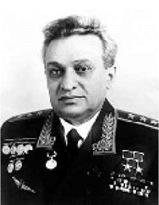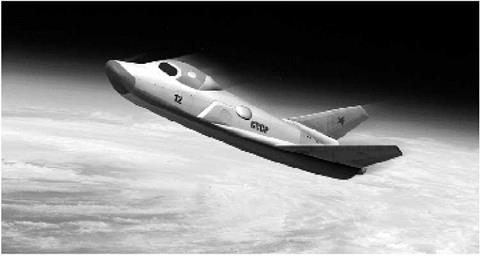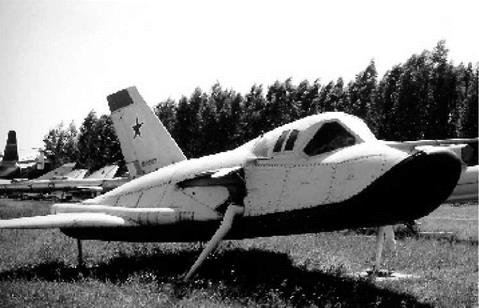Mikoyan’s Spiral
Despite Dyna-Soar’s cancellation in December 1963, interest in spaceplanes did not abate. Although virtually all proposals adhered to the Dyna-Soar type boost-glide principle, the Soviet Air Force displayed increasing interest in the early 1960s in air – launched spaceplanes. Unlike the rocket-launched spaceplanes, these would not be
|
Artyom Mikoyan. |
tied to specific launch sites and could be launched from virtually any place in the world into a wide variety of orbital inclinations. This made the system less vulnerable to attack and gave it far more flexibility in fulfilling key military objectives such as timely reconnaissance of ground-based enemy targets and inspection and neutralization of enemy satellites. Air-launched systems were promoted at an Air Force conference at the Monino Air Force Academy in January 1962 [24]. Studies conducted in 1964-1965 by the Soviet Air Force research institute TsNII-30 also concluded that an air-launched vehicle would best meet the military requirements formulated for spaceplanes.
On 30 July 1965 the Ministry of the Aviation Industry (MAP) assigned the task of building such a system to the OKB-155 design bureau of Artyom Mikoyan. Renamed MMZ Zenit in 1966, the bureau was most renowned for its MiG fighter jets, but at the same time was no stranger to air-launched systems. Back in the 1950s Mikoyan had been involved in the development of the air-launched Kometa anti-ship cruise missile and in the early 1960s he had briefly worked on an air-to-space missile to be launched from a MiG-25 to destroy enemy missiles in flight [25]. In a newspaper article in January 1962, coinciding with the Air Force conference in Monino, Mikoyan had even publicly proclaimed the need for what he called a kosmolyot (a compound of kosmicheskiy samolyot, “spaceplane”) to provide the Soviet Air Force with an operational capability in space [26].
Mikoyan’s team wasted no time in getting down to business and by July 1966 had completed a preliminary design for the air-launched spaceplane system, called Spiral. Placed in charge of the project was 55-year-old Gleb Yevgenyevich Lozino-Lozins – kiy, a deputy of Mikoyan who had worked at the bureau since 1941 and had played a crucial role in the development of propulsion systems (especially afterburners) for numerous MiG jets. As a sign of his dedication to Spiral, Mikoyan set up a special space branch of his design bureau in the town of Dubna in April 1967. This was located on the same premises where Pavel Tsybin’s OKB-256 had worked on the PKA spaceplane a decade earlier. The chief of the branch was Pyotr A. Shuster and
 |
the head of its design bureau Yuriy D. Blokhin. Lozino-Lozinskiy’s deputy was Gennadiy P. Dementyev, the son of Minister of the Aviation Industry Pyotr Dementyev.
Spiral was a 115-ton system consisting of a Hypersonic Boost Aircraft (GSR or “Product 50-50’’), an Orbital Plane (OS), and a two-stage rocket to place the OS into orbit. The GSR, probably supposed to be built by the Tupolev bureau, was a 38 m long aircraft with a wingspan of 16.5 m and four air-breathing turbojet engines fixed under the main fuselage. An early version would burn kerosene and the final one hydrogen, with hydrogen gas being used to drive the turbine that in turn rotated the turbojet compressor. The two-stage rocket mounted on the back of the GSR was to be propelled by liquid oxygen/liquid hydrogen engines, but the designers ultimately wanted to replace the oxygen by fluorine. Although this is a highly toxic substance, it provided a higher specific impulse and would require smaller tanks than the LOX version. The hydrogen/fluorine engines were to be developed by Glushko’s Energomash design bureau, which by that time had already acquired extensive experience with testing fluorine-based engines.
When picking the shape of the spaceplane, Mikoyan’s engineers may at least partially have been inspired by flight tests of suborbital and atmospheric lifting bodies in the United States in the early 1960s, but in the end they came up with their own, unique design. The spaceplane proper was an 8 m long flat-bottomed lifting body with a large upturned nose and wings that could be rotated to vertical position during launch and the initial portion of re-entry. The vehicle’s aerodynamic design was such that thermal stresses during re-entry were minimized. The spacecraft’s reusable heat shield was not solid, but was composed of a set of sheets, much like a fish’s scales. Suspended on ceramic bearings, these sheets could move relative to the vehicle’s body as the temperatures on various parts of the ships changed during re-entry. The plates were made of a niobium alloy with a molybdenum disilicide coating and could withstand temperatures up to about +1,500°C.
Situated in the front was the single pilot’s cockpit, which in case of an emergency could be ejected from the spaceplane and land by parachute. The headlight-shaped
|
Spiral spaceplane in orbit (source: www. buran. ru). |
capsule even had a small engine and a heat shield to deorbit and re-enter independently if an emergency arose in orbit. The power plant, located in the back, consisted of a single main engine for changing orbital inclination and deorbiting, two back-up deorbit engines, 16 attitude control thrusters, and a turbojet engine for subsonic propulsion and landing. The landing gear was made up of four skids mounted on the sides of the spaceplane.
In between the cockpit and the engine compartment was a 2 m3 payload section stowed full with reconnaissance equipment or weapons, depending on the mission. There were two reconnaissance versions of the spaceplane, one with optical cameras with a resolution of up to 1.2 m for detailed photography and another with an externally mounted radar antenna with a resolution of 20-30 m for spotting large objects such as aircraft carriers. An attack version of the OS was designed to destroy sea-based targets with a 1,700 kg nuclear-tipped space-to-surface missile, which required an additional 2m3 of volume in the mid-section of the spaceplane (at the expense of fuel).
Finally, there were two interceptor versions of the spaceplane. One was supposed to catch up with targets in orbit for close inspection and had six 25 kg homing missiles on board for destroying them (if necessary) from a maximum range of 30 km. The other was a long-range interceptor outfitted with 170 kg homing missiles to neutralize targets from a maximum distance of 350 km. Both interceptor versions had enough fuel on board to destroy two targets orbiting at altitudes of up to 1,000 km. The OS weighed 8.8 tons in all configurations, carrying 500 kg of payload for reconnaissance and interception missions, and 2,000 kg in its attack configuration.
A typical Spiral mission would begin with the GSR taking off at a speed of 380400 km/h using a “launch truck”. Having accelerated the system to a hypersonic speed of Mach 6, the carrier aircraft would release the OS/booster combination at an altitude of 28-30 km and return to its home base. Subsequently, the two-stage rocket would place the spaceplane into a low orbit of approximately 130 x 150 km with inclinations varying between 45 and 135° (if launched from the territory of the USSR). If equipped with a main engine burning liquid fluorine (F2) and amidol (50% N204, 50% BH3N2H4), the reconnaissance and interception versions could change their inclination by 17° for a second target run and the attack version by 7-8°. The interception version could also simultaneously change inclination by 12° and ascend to an altitude of up to 1,000 km.
After a mission of maximum three orbits, the spaceplane would fire its deorbit engine and dive into the atmosphere at a 45-60° angle of attack with the wings folded to near-vertical position, allowing the air stream to flow from the body down to the wings, rather than to the wing leading edges. Cross-range capability was between 1,100 and 1,500 km, offering the pilot much flexibility in choosing landing sites. After unfolding the wings to a near-horizontal position and igniting the turbojet engine, the pilot would land the spaceplane on a dirt runway at a speed of no more than 250 km/h.
According to plans formulated in the preliminary design in 1966 the Spiral program was to be conducted in four stages. The first step was to build three suborbital prototypes and launch them from the back of a Tu-95KM aircraft, the same type of plane Tupolev had intended to use for his own spaceplane tests. Subsonic flights were to begin in 1967, followed by X-15 type supersonic and hypersonic flights in 1968 to altitudes of 120 km and speeds of Mach 6-8. In the second stage Soyuz rockets would be used to launch full-scale versions of the 0S (“EPOS”) into orbit on both unmanned and manned missions in 1969 and 1970, with one of the mission objectives being to perform an 8° plane-changing burn. Stage 3 would see test flights of a kerosene-fueled version of the GSR in 1970, with the hydrogen-fueled version being introduced in 1972. That same year the fourth stage was to begin with an all-up test of the Spiral complex using a kerosene-fueled GSR and a LOX/liquid hydrogen rocket booster. In 1973 the hydrogen-fueled GSR would be used for a manned test of the Spiral system. Later steps were the introduction of fluorine-based engines for both the rocket and the spaceplane and the replacement of the expendable rocket by a reusable rocket with hypersonic scramjet engines burning liquid hydrogen.
Spiral was by far the largest-scale Soviet spaceplane program of the 1960s, although the amount of money invested in it must still have been dwarfed by what the US Air Force spent on Dyna-Soar. It was also the first for which cosmonauts began training. A Spiral training group was set up at Star City in 1966 and existed until 1973. The Air Force cosmonauts known to have been involved in Spiral at one time or another are Gherman Titov, Anatoliy Kuklin, Vasiliy Lazarev, Anatoliy Filipchenko, Leonid Kizim, Anatoliy Berezovoy, Vladimir Dzhanibekov, Vladimir Kozelskiy, Vladimir Lyakhov, Yuriy Malyshev, Aleksandr Petrushenko, and Yuriy Romanenko. The training mainly involved flying a variety of aircraft from an Air Force test site in Akhtubinsk (Volgograd region) to acquire the status of test pilot.
By the end of the 1960s the Spiral project had still not been officially sanctioned by a party/government decree. One man who tried to change that situation was
Nikolay Kamanin, the Air Force Commander-in-chief’s Aide for Space Matters, who had been pushing for spaceplanes since the early 1960s, seeing them as a logical extension of military aircraft. Sometime in late 1969 Kamanin and his entourage worked out a draft for such a decree to be sent to the Council of Ministers and the Central Committee. The draft was supposed to be signed by seven ministers and high – ranking military officials, but, as Kamanin recounts in his diaries, by April 1970 only four had done so. The delay was caused at least partly by a conflict that had arisen over the missions of future spaceplanes between Sergey Afanasyev, who headed the Ministry of General Machine Building (MOM, the “space and missile ministry’’), and Minister of the Aviation Industry Pyotr Dementyev. Afanasyev had signed the draft with the remark that besides military spaceplanes there should also be winged spacecraft adapted as transportation systems. Subsequently, Dementyev refused to put his signature under it, fearing that the organizations under his ministry would become overloaded with space-related work, which was not their primary line of business.
In the middle of 1970 Defense Minister Andrey Grechko sent a letter to Central Committee Secretary for Defense Matters Dmitriy Ustinov, in which he justified the need to build spaceplanes and asked him to order several ministries to reach a consensus on a draft government decree on Spiral. Three months later that was apparently achieved, but by that time Grechko, who was not at all space-minded, seems to have had a change of heart on the issue. When the moment came for him to sign the draft himself, he vetoed it, writing on the document in question that Spiral was “a fantasy’’ and that money should be spent on more realistic things. Grechko’s rejection of the draft sounded the death knell for Spiral. Kamanin asked Air Force Commander-in-Chief Pavel S. Kutakhov (assigned to the post in March 1969) to try and change Grechko’s mind, but Kutakhov himself seems to have shown little enthusiasm for the project [27]. To make matters even worse, Mikoyan, backing the program with his authority, died in December 1970, and Lozino-Lozinskiy was forced to divert his attention from space matters after having been assigned chief designer of the new MiG-31 interceptor in 1971.
All this meant that by the turn of the decade the prospects for Spiral were very bleak indeed. Aside from interdepartmental squabbling and budgetary issues, other reasons for the lukewarm interest in Spiral may have been the challenges involved in mastering advanced technologies such as the hypersonic carrier aircraft and the reusable heat shield. In addition to that, it was probably realized by now that at least some of the missions planned for Spiral could just as well be performed by unmanned satellites.
Remarkably enough, the program continued on what appears to have been a semi-legal basis and eventually did see some hardware make it off the ground, even after the Buran program was approved in 1976. Why Spiral wasn’t canceled outright is a fact that remains to be satisfactorily explained. In the mid-1970s designers looked at enlarged versions of the Spiral spaceplane to be launched by the Proton rocket or the massive Energiya booster (see Chapter 2), but these appear to have been shortlived paper studies not enough to justify the continuation of a test flight program.
Recent evidence indicates MAP may eventually have seen Spiral as no more than a trump card in a seemingly mundane tug-of-war with MOM over subordinate organizations. One source of acrimony between the two ministries was that many factories and research institutes of MAP had been transferred to MOM after the latter’s establishment in 1965. Around the mid-1970s Lozino-Lozinskiy and MAP deputy minister Aleksey Minayev reportedly convinced MAP minister Dementyev that by demonstrating its ability to fly Spiral hardware, MAP would eventually muster the political support required to have some of those organizations transferred back to its ranks. Another factor enabling the continuation of Spiral may have been the death in April 1976 of Defense Minister Grechko, one of the program’s most vigorous opponents [28].
Whatever the real motives for keeping Spiral alive, several test flights were conducted in support of the program between 1969 and 1978. The Gromov Flight Research Institute (LII) built several scale models of the spaceplane known as BOR-1, 2 and 3 (“Unmanned Orbital Rocket Plane’’). These were launched on suborbital trajectories by R-12 missiles from Kapustin Yar between 1969 and 1974. A full-scale prototype for subsonic flights (105.11, nicknamed “Lapot” or “Bast Shoe’’ and sometimes also called EPOS, like the orbital test bed) was ready for test flights by the mid-1970s. Staged from the Air Force site in Akhtubinsk, they began in December 1975 with a series of taxi runs and brief flights (first in June 1976) in which the plane took off on its own power. At the helm for those tests were civilian test pilots Aviard Fastovets, Valeriy Menitskiy, Vasiliy Uryadov, Igor Volk, and Aleksandr Fedotov. After a number of “captive-carry’’ tests, the 105.11, piloted by Fastovets, was dropped from the belly of a Tu-95K from an altitude of 5 km for the
|
The 105.11 atmospheric test bed (B. Hendrickx). |
first time in October 1977. Five more drop tests followed the following months, three performed by Fastovets, one by Pyotr Ostapenko, and one by Uryadov. The final one in September 1978 ended with the plane making a hard landing to the right of the runway, causing some damage to the landing gear. The 105.11 was never refurbished for another flight. It can still be seen today at the Monino Air Force museum outside Moscow. A model for supersonic tests (105.12) was built but never flown and a model for hypersonic tests (105.13) was partially built.
Apparently, Spiral died a silent death in the late 1970s as work on Buran got underway in earnest. It did have at least one important legacy for the Buran program. A subscale model (BOR-4) originally intended for orbital test flights of the Spiral spaceplane was eventually launched on single-orbit missions in 1982-1984 to test materials for Buran’s thermal protection system (see Chapter 6). The work on Spiral also served as the basis for studies of new air-launched spaceplanes in the 1980s and 1990s, particularly the MAKS project (see Chapter 9) [29].













